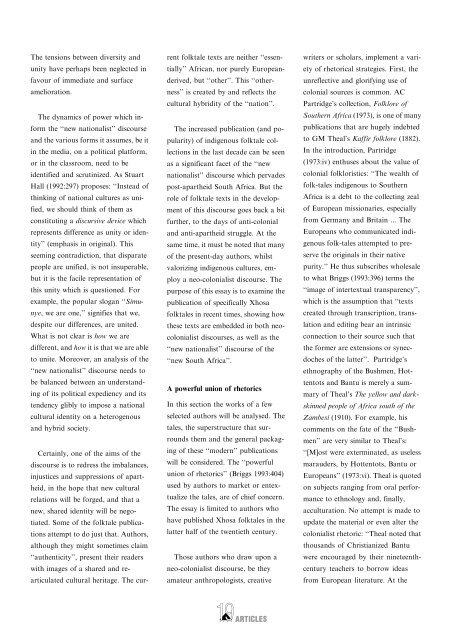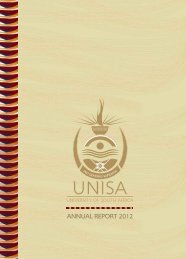Editor Co-editor Associate Editors Editorial Board - University of ...
Editor Co-editor Associate Editors Editorial Board - University of ...
Editor Co-editor Associate Editors Editorial Board - University of ...
Create successful ePaper yourself
Turn your PDF publications into a flip-book with our unique Google optimized e-Paper software.
The tensions between diversity and<br />
unity have perhaps been neglected in<br />
favour <strong>of</strong> immediate and surface<br />
amelioration.<br />
The dynamics <strong>of</strong> power which inform<br />
the ``new nationalist'' discourse<br />
and the various forms it assumes, be it<br />
in the media, on a political platform,<br />
or in the classroom, need to be<br />
identified and scrutinized. As Stuart<br />
Hall (1992:297) proposes: ``Instead <strong>of</strong><br />
thinking <strong>of</strong> national cultures as unified,<br />
we should think <strong>of</strong> them as<br />
constituting a discursive device which<br />
represents difference as unity or identity''<br />
(emphasis in original). This<br />
seeming contradiction, that disparate<br />
people are unified, is not insuperable,<br />
but it is the facile representation <strong>of</strong><br />
this unity which is questioned. For<br />
example, the popular slogan ``Simunye,<br />
we are one,'' signifies that we,<br />
despite our differences, are united.<br />
What is not clear is how we are<br />
different, and how it is that we are able<br />
to unite. Moreover, an analysis <strong>of</strong> the<br />
``new nationalist'' discourse needs to<br />
be balanced between an understanding<br />
<strong>of</strong> its political expediency and its<br />
tendency glibly to impose a national<br />
cultural identity on a heterogenous<br />
and hybrid society.<br />
Certainly, one <strong>of</strong> the aims <strong>of</strong> the<br />
discourse is to redress the imbalances,<br />
injustices and suppressions <strong>of</strong> apartheid,<br />
in the hope that new cultural<br />
relations will be forged, and that a<br />
new, shared identity will be negotiated.<br />
Some <strong>of</strong> the folktale publications<br />
attempt to do just that. Authors,<br />
although they might sometimes claim<br />
``authenticity'', present their readers<br />
with images <strong>of</strong> a shared and rearticulated<br />
cultural heritage. The current<br />
folktale texts are neither ``essentially''<br />
African, nor purely Europeanderived,<br />
but ``other''. This ``otherness''<br />
is created by and reflects the<br />
cultural hybridity <strong>of</strong> the ``nation''.<br />
The increased publication (and popularity)<br />
<strong>of</strong> indigenous folktale collections<br />
in the last decade can be seen<br />
as a significant facet <strong>of</strong> the ``new<br />
nationalist'' discourse which pervades<br />
post-apartheid South Africa. But the<br />
role <strong>of</strong> folktale texts in the development<br />
<strong>of</strong> this discourse goes back a bit<br />
further, to the days <strong>of</strong> anti-colonial<br />
and anti-apartheid struggle. At the<br />
same time, it must be noted that many<br />
<strong>of</strong> the present-day authors, whilst<br />
valorizing indigenous cultures, employ<br />
a neo-colonialist discourse. The<br />
purpose <strong>of</strong> this essay is to examine the<br />
publication <strong>of</strong> specifically Xhosa<br />
folktales in recent times, showing how<br />
these texts are embedded in both neocolonialist<br />
discourses, as well as the<br />
``new nationalist'' discourse <strong>of</strong> the<br />
``new South Africa''.<br />
A powerful union <strong>of</strong> rhetorics<br />
In this section the works <strong>of</strong> a few<br />
selected authors will be analysed. The<br />
tales, the superstructure that surrounds<br />
them and the general packaging<br />
<strong>of</strong> these ``modern'' publications<br />
will be considered. The ``powerful<br />
union <strong>of</strong> rhetorics'' (Briggs 1993:404)<br />
used by authors to market or entextualize<br />
the tales, are <strong>of</strong> chief concern.<br />
The essay is limited to authors who<br />
have published Xhosa folktales in the<br />
latter half <strong>of</strong> the twentieth century.<br />
Those authors who draw upon a<br />
neo-colonialist discourse, be they<br />
amateur anthropologists, creative<br />
~19 .... ARTICLES<br />
writers or scholars, implement a variety<br />
<strong>of</strong> rhetorical strategies. First, the<br />
unreflective and glorifying use <strong>of</strong><br />
colonial sources is common. AC<br />
Partridge's collection, Folklore <strong>of</strong><br />
Southern Africa (1973), is one <strong>of</strong> many<br />
publications that are hugely indebted<br />
to GM Theal's Kaffir folklore (1882).<br />
In the introduction, Partridge<br />
(1973:iv) enthuses about the value <strong>of</strong><br />
colonial folkloristics: ``The wealth <strong>of</strong><br />
folk-tales indigenous to Southern<br />
Africa is a debt to the collecting zeal<br />
<strong>of</strong> European missionaries, especially<br />
from Germany and Britain ... The<br />
Europeans who communicated indigenous<br />
folk-tales attempted to preserve<br />
the originals in their native<br />
purity.'' He thus subscribes wholesale<br />
to what Briggs (1993:396) terms the<br />
``image <strong>of</strong> intertextual transparency'',<br />
which is the assumption that ``texts<br />
created through transcription, translation<br />
and editing bear an intrinsic<br />
connection to their source such that<br />
the former are extensions or synecdoches<br />
<strong>of</strong> the latter''. Partridge's<br />
ethnography <strong>of</strong> the Bushmen, Hottentots<br />
and Bantu is merely a summary<br />
<strong>of</strong> Theal's The yellow and darkskinned<br />
people <strong>of</strong> Africa south <strong>of</strong> the<br />
Zambesi (1910). For example, his<br />
comments on the fate <strong>of</strong> the ``Bushmen''<br />
are very similar to Theal's:<br />
``[M]ost were exterminated, as useless<br />
marauders, by Hottentots, Bantu or<br />
Europeans'' (1973:vi). Theal is quoted<br />
on subjects ranging from oral performance<br />
to ethnology and, finally,<br />
acculturation. No attempt is made to<br />
update the material or even alter the<br />
colonialist rhetoric: ``Theal noted that<br />
thousands <strong>of</strong> Christianized Bantu<br />
were encouraged by their nineteenthcentury<br />
teachers to borrow ideas<br />
from European literature. At the
















